Looking for the best resources to expand your knowledge of solar energy? Look no further! In this article, we will explore the top 10 books on solar energy that cover a wide range of topics, from solar panel technology and design to renewable energy policy and economics. Whether you’re a seasoned professional in the solar industry or a newcomer interested in sustainable energy, these books offer valuable insights and practical information to help you navigate the world of solar power.

From comprehensive guides on solar photovoltaic systems to in-depth analyses of the solar industry’s impact on global energy markets, these books provide a wealth of information for anyone interested in harnessing the power of the sun. Whether you’re looking to install solar panels on your home or seeking to understand the broader implications of solar energy on a global scale, these top 10 solar energy books offer something for everyone. So, let’s dive into the world of solar energy literature and discover the essential reading material for anyone passionate about sustainable energy solutions.
Top Solar Energy Books for Learning & Innovation
1. Mr. Michael Boxwell: Solar Electricity Handbook: A Simple Practical Guide to Solar Energy

The Solar Electricity Handbook – 2021 Edition is a softcover how-to penned by Michael Boxwell, and what it’s quietly known for is being a no-frills, beginner’s doorway into solar PV (photovoltaic) systems, something you can actually read without feeling like you’ve stepped into a math thesis or engineering jargon soup.
This fourteenth edition (2021) runs about 242 pages, light for a technical book, but you know, enough to thumb through and not feel overwhelmed. From the handful of reviews we dug through, mostly on Amazon and a smattering on Goodreads, the general feeling is that Boxwell keeps things simple, even hand-holding at times, which beginners appreciate. A few readers wanted more meat on the technical side, saying it skims along rather than digging trenches. And the Goodreads rating looks high, almost suspiciously so, though it’s based on only a dozen or so people. Not exactly a crowd sample, but still useful as a signal.
Stand-out feature: The book’s strength, in our research, is its accessible tone and inclusion of online tools, solar calculators, and direct author contact for practical questions. That’s bridging the print and digital seamlessly.
Drawback: From what users imply, and reflecting on forums of our peers (though not this edition specifically), the content might be a bit too elementary, particularly for readers familiar with electrical code or seeking in-depth design engineering (some forums note, on similar technical handbooks, only a small percentage covers code specifics). For instance, it could feel like a gentle walk when what you wanted was a brisk climb.
✅ Pros
- Accessibly written; assumes no prior PV knowledge.
- Includes online calculators and author contact for real-world follow-up.
- Succinct (~242 pages), yet it covers installation from scratch.
⚠️ Cons
- It may feel too basic for technically minded readers.
- Limited depth on code/design nuances.
- Only a handful of user reviews; community feedback is sparse.
Earthava’s take: Ideal for curious homeowners, budding researchers, students taking first steps (someone who wants a friendly, grounded intro without jargon). If you’re already knee-deep in NEC code or an installer, this might feel like an amiable chat rather than a full technical dive.
The Author: Michael Boxwell has written about technology and the environment since 2003. His first book was The Proof of Delivery Buyer’s Guide, and he has since written the Solar Electricity Handbook (now in its eleventh edition) and The Electric Car Guide series of books.
2. Soteris A. Kalogirou: Solar Energy Engineering: Processes and Systems
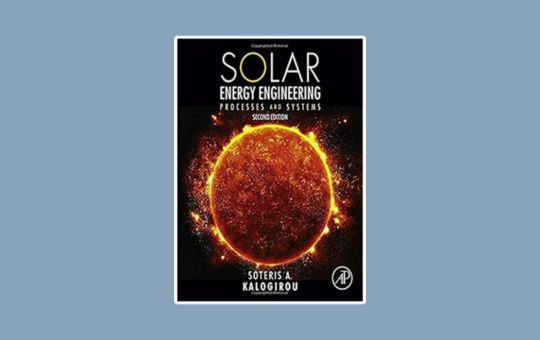
Solar Energy Engineering: Processes and Systems (2nd Edition), a hefty, hardcover guide (around 840 pages) published circa 2013–2014, is known for truly spanning the solar energy landscape, from basic solar radiation to advanced system modeling and even a fresh chapter on wind systems, so you feel you’re not just reading but traveling through the discipline.
In our research, the book’s breadth stands out, seriously, almost every aspect of solar engineering gets a turn in the spotlight: collectors, thermal systems, photovoltaics, economic modeling, and yes, wind too. Kalogirou is hardly a first-timer; his decades of academic and editorial work show that Academic Press thought ‘world-renowned expert’ was a box worth checking.
One standout feature (and it sort of leans into the nerdy charm) is the inclusion of detailed reference tables, schematic diagrams, and even a discussion of modeling tools and AI applications in solar systems. It reads like an engineer’s Swiss Army knife, and our research shows these are exactly the bits professionals and students lean on.
But there’s a snag: according to a mechanical-engineer user on Reddit, who jumped in with “found this text very easy to read and understand,” but also flagged that “if you have a lot of experience this may be a bit basic for you” certain topics, like photovoltaics or BIPV, barely scratch the surface compared to other depth-heavy specialized texts.
✅ Pros
- Wide-ranging coverage, from fundamentals to AI-assisted modeling
- Packed with diagrams, tables, updated content (including wind)
- Authored by a true expert with deep academic roots
⚠️ Cons
- Feels a touch introductory for seasoned engineers
- PV/electrical sections are somewhat lightweight, introductory-level
- Dense 840 pages might overwhelm casual readers
Who’s this for? Students dipping toes into solar engineering, early-career professionals seeking a grounded yet broad reference, and academics who need a go-to handbook that isn’t embarrassingly thin.
The Author: Professor Soteris Kalogirou is the Dean of the School of Engineering and Technology at the Cyprus University of Technology in Limassol, Cyprus. He received his PhD from the University of Cambridge.
3. Ryan Mayfield: Photovoltaic Design and Installation

You’ve landed in a warren of solar-energy books; this one crawls in with a comfortable, accessible tone, but is no lightweight. Photovoltaic Design & Installation For Dummies (first published in 2010, updated 2019 cover but same content) is best known for translating the messy physics and codes of home-scale PV systems into plain(ish) speak. Covers history, component deep-dives (modules, inverters, wiring), system sizing, permitting, and even prepping you for the NABCEP exam.
Specs and features: there’s a scatter of useful bits: about 384–400 pages, solid paperback dimensions (roughly 9.2 × 7.3 × 0.9 inches), from Wiley/For Dummies. And content-wise: everything from basic electricity to site surveys to safety and commissioning. It’s wide-ranging, coherent (i.e., you won’t find yourself lost in jargon, mostly).
One standout feature is how the book handles the everyday stuff, not just the formulas. Like figuring out which way panels should face, or the whole azimuth vs. true north debate. Several readers on retail sites said those explanations saved them from feeling lost in technical jargon. It’s not revolutionary, but it does ground the book in the kind of real-world choices you’d run into on a roof or at a job site. (That practical tilt is what makes it stand out from some of the more purely academic solar texts.)
But, and here’s the rub, our research shows (based on reviews) that off-grid systems are lightly treated; one verified buyer called it “lightweight on off-grid”. So if your head’s set on totally off-grid mastery, you might feel a bit adrift.
Ideal for? Building pros, students, savvy homeowners, maybe folks prepping for NABCEP, who want a friendly yet thorough guide to on-grid PV systems. But off-grid purists or seasoned engineers may want to layer on more specialized texts.
✅ Pros
- Thorough on design & installation basics
- Clear explanations of system sizing, codes, and components
- Good for NABCEP prep, practical enough for DIYers
⚠️ Cons
- Sparse coverage of off-grid systems
- Some may find the “For Dummies” tone too casual
Earthava’s take: This book is like that reliable friend who knows solar but doesn’t pretend to dazzle. It doesn’t oversell; it walks you through wiring, permitting, safety, commissioning, in the kind of cadence that says, “Yes, you can do this (maybe after that confusing permit form).” One feels the author’s 20+ years in the field (since 1999) breathing through the pages; Mayfield’s cred is subtle but real. To close, there’s no neat bow, just a friendly nudge: if you’re stepping into solar design, especially grid-tethered, here’s a grounded, credible companion. But if your horizon is deep off-grid or cutting-edge innovation, this is part one, good, honest, but not the whole picture.
The Author: Ryan Mayfield is the President of Renewable Energy Associates, a consulting firm providing design, support, and educational services for commercial photovoltaic systems.
4. Solar Energy International: Photovoltaics: Design and Installation Manual
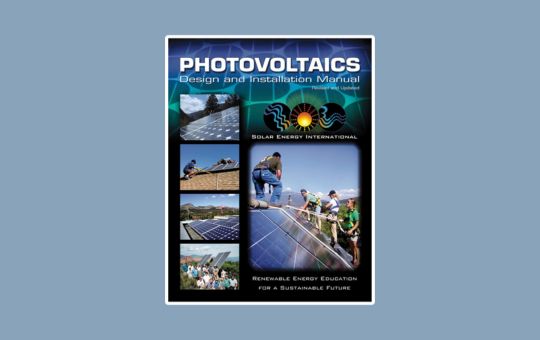
So here’s this manual, Photovoltaics: Design and Installation Manual, from Solar Energy International, that people keep reaching for when they want the tough, workshop-worn version of solar know-how. It’s known for being the SEI textbook in real-world workshops, but even when you’re not sitting in their classroom, the book’s full of practical, nuts-and-bolts content (that solar insolation table section for over 300 sites? Anyone sizing systems will pat the page as dearly earned).
Specs and features: about 320 pages, trade paperback measuring roughly 10.8 by 8.3 by 1.1 inches, weighs in around 32 ounces, illustrated (so diagrams aren’t abstract, they feel tactile). Contents, electric principles, modules, batteries, wiring, off-grid, utility-interactive systems, safety, troubleshooting, basically cover the whole installation circus, plus those appendices on system maintenance, case studies, cost economics, and yes, that insolation stuff.
One standout feature, according to users, is the clarity when it gets hands-on: sizing a battery-based or hybrid system, laying out wiring, or diving into system controls without gloss. A reviewer said they were in the middle of designing their own system and found “very useful information and advice” hiding in there. That feels like clumsy gold, not marketing spin.
But, this isn’t perfect. Our research shows this book can feel complicated for casual readers; one buyer noted how a materials list for a 12-volt DC battery / charge-controller setup ran to 80 individual lines, each with numbers, costs, specifications, so if you just want a breezy intro, this may drown you in detail.
Who is this for? Probably serious students, DIY installers with spreadsheet-savvy, vocational classes, SEI workshop participants, or early-career solar techs who like diagrams as much as jargon. But “just curious” readers might be a bit lost.
✅ Pros
- Real-world system sizing, wiring, and off-grid detail
- Includes global insolation data for 300+ sites
- Solid diagrams and illustrations
⚠️ Cons
- Overly dense for casual readers
- First published 2004; may feel dated in pace or examples
- Not the friendliest tone, more workshop manual than café
Earthava’s take: And look, no tidy sign-off, because solar design isn’t neat, and neither are we. It’s a durable, believable workhorse of a manual. If you’re stepping into design or installation for real gritty reality, permits, wires, and panels, this book holds your hand in the shadows. But if you just wanted a sunny overview? You might pause here.
The Author: Solar Energy International (SEI) is a nonprofit organization that trains people in the use of solar energy. They offer hands-on workshops and online courses in many countries. Learn more about us or buy books and other learning tools directly from us at www.solarenergy.org
5. John Perlin: Let It Shine: The 6,000-Year Story of Solar Energy
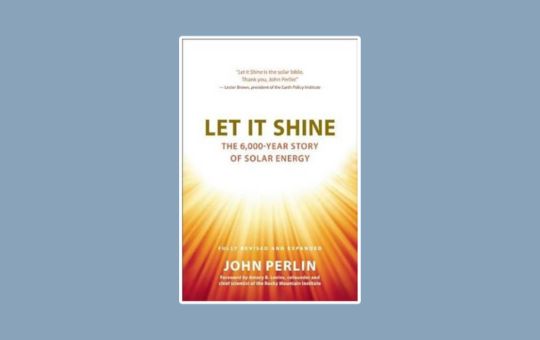
Let It Shine shares these with us to reveal the surprising extent to which humans have understood and harnessed sunlight, and the latest breakthroughs that may one day enable us to colonize space.
This book is a fascinating look at how people have used solar energy throughout time, how it relates to human development, and where we may be headed in our search for other planets where humans can live.
Hardcover: $18.95
Paperback: $24.95
The Author: John Perlin, a pioneer in solar history and technology, has been collecting anecdotes and stories about the sun from all around the globe for over forty years.
6. Andy Walker: Solar Energy: Technologies and Project Delivery for Buildings
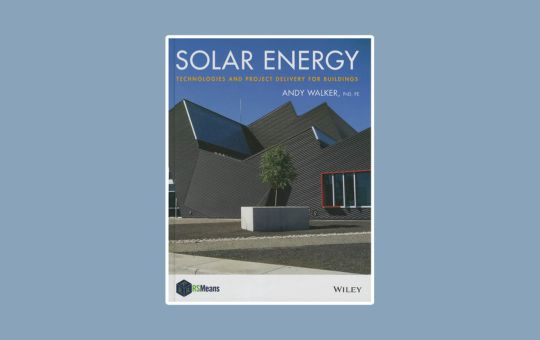
This book doesn’t try to be flashy. It feels like a professional tool, written by Andy Walker, PhD, a senior engineer at the U.S. National Renewable Energy Lab, who’s spent years working on actual solar projects rather than just theory. First published in 2013 by Wiley, it runs about 320 pages and is sized more like a workbook than a casual paperback.
Specs & content: It walks through every stage of solar project development for buildings, from feasibility analysis to design, financing, codes, and delivery. You’ll find sample schematics, cost-estimation tables, and even checklists that act almost like a project manager’s clipboard. There are case studies (real-world examples of how projects were executed), plus tips and warnings scattered throughout. Unlike some solar guides aimed at DIY enthusiasts, this one positions itself squarely in the professional design/engineering space
One standout feature: the project delivery framework. According to research summaries and publisher notes, the step-by-step documentation, checklists, and code references help architects and MEP engineers navigate what is usually a messy, fragmented process. It doesn’t just explain solar tech; it shows how to integrate it into actual building projects.
But here’s the drawback: it’s heavy reading for anyone without a technical or construction background. Several third-party reviewers have noted that the book may be “overwhelming” for newcomers and doesn’t provide installation walk-throughs. If you’re looking for a hands-on DIY manual, this won’t scratch that itch.
Who is this for? architects, project managers, engineers, or advanced students, people who need structured tools for professional solar integration. Not a light weekend read.
✅ Pros
- Detailed checklists, cost tables, and real project examples
- Written by a respected NREL engineer
- Focuses on project delivery, not just theory
⚠️ Cons
- Dense for non-technical readers
- Lacks practical “how-to-install” instructions
Earthava’s take: This book is less about glossy inspiration and more about rolling up your sleeves. If you’re serious about solar projects in buildings, from design desk to delivery, it earns its keep.
The Author: Andy Walker is a recognized authority on solar energy and a thought leader in the optimization of energy systems. He currently serves as Principal Engineer at the National Renewable Energy Laboratory, where he conducts engineering and economic analysis of energy efficiency projects for Federal agencies such as national parks and military bases. He also provides consulting services to commercial and industrial clients.
7. Off-Grid Solar Power Simplified By Nick Seghers
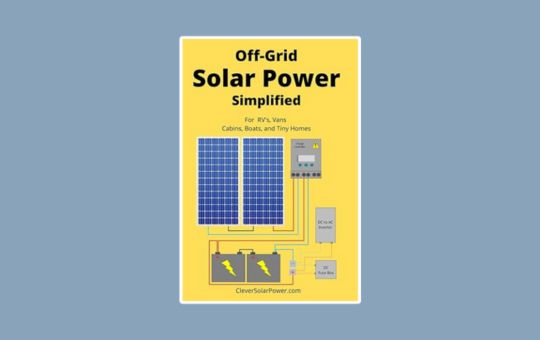
This book is all over the place in a good way. According to user reviews on Goodreads, it’s praised for clear explanations and practical advice, “a one-stop shop for everything you need to know about going solar”. But one reader pointed out that “at times there was a bit too much detail,” which kind of rings true; some sections feel like drinking from a firehose if you’re nibbling on DIY projects.
Specs and features: A 300-plus page paperback. Written by an electrical-engineering-leaning solar expert and vetted by a licensed electrician, so it’s not just hearsay. Covers everything: energy units, formulas, tools, wiring, batteries, panels, inverters, and step-by-step system building. Also diagrams, safety tips, fire protection… really quite thorough
One standout feature? Wire sizing and safety tips. Many reviewers have noted that the wiring chapter, with fuses and diagrams, is a high-value anchor in the book for beginners. It’s rare to see that handled so carefully in handheld guides, so big plus there.
But there’s a drawback: overwhelming detail for the casual reader. As one Goodreads reviewer said, it’s “much better than some drivel out there,” yet still “a bit too much detail.” That’s not fluff; our research shows that casual DIY-ers might skip chapters or feel a bit lost in the deep end.
Ideal for: someone who’s earnest about building a robust off-grid system, RV travelers, tiny-home dwellers, and cabin nuts. If you’re ready to dive into the nitty-gritty, this is a treasure. This is not for someone who only wants quick hacks or a broad overview.
✅ Pros
- Deep technical guidance (especially on wiring, safety, diagrams)
- Authoritative voice, cross-checked by an electrician
- Broad coverage, from units to inverters to battery configs
⚠️ Cons
- Can feel dense, some users say “too much detail,” ironically making “simplified” feel heavy
- Layout occasionally methodical to the point of dryness (a gentle yawn, if you’re skimming)
Earthava’s take: This book stands out when you do want real technical clarity, not just pretty visuals. And yes, if the depth is what you’re after, it earns its space on your shelf (or table, or workbench).
8. Allan Fowler: Energy from the Sun: (Rookie Read-About Science: Earth Science) (For Kids)
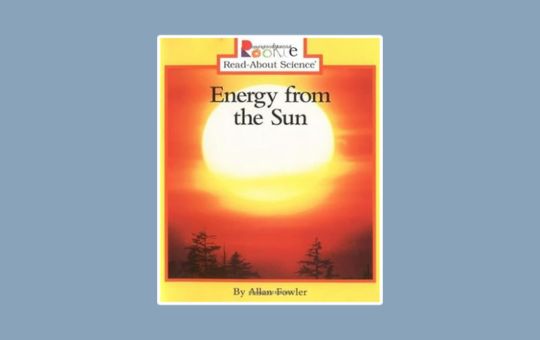
Dive into the world of science with the energy from the sun. This book provides young readers with information about life on Earth and how it is affected by energy from the sun. With striking photographs and easy-to-read text, this book allows kids to learn about solar energy, why it is important, and how animals use it in their everyday lives.
Paperback: $11.40
The Author: Allan Fowler is the author of children’s books. In addition to his titles Can You See the Wind? and Sun’s Family of Planets (Rookie Read-About Science), he has also written Upside-Down Sloth and We Love Fruit.
9. Sean White: Solar Photovoltaic Basics
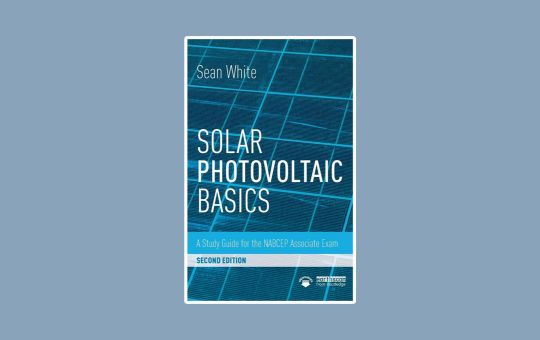
Imagine you’re craving clarity on solar PV, but drowning in dense textbooks. Step into this guide: lean hardcover, about 314 pages, portable (roughly 4.9 × 7.5 inches), a focused companion for those prepping the NABCEP PV Associate. It promises, and so delivers, a digestible walkthrough of all ten core modules tied to the exam syllabus, from Markets & Applications to Troubleshooting. Let’s wander through what’s actually working, and where the shine dims.
This is not your coffee-table solar fluff. It’s an exam-centric study guide, structured around NABCEP’s official learning objectives. In our research, we confirmed it’s widely recognized by instructors as a go-to text, some even say it’s the “primary text” they recommend. Goodreads and Amazon both note that Sean has a knack for breaking down photovoltaic science in accessible ways, even for folks without engineering degrees
Standout feature: the clarity. According to users, the explanations are “understandable to those without engineering degrees” and it echoes the exam’s structure so closely, instructors rely on it heavily. That alignment isn’t fluff, it’s fundamental.
But here’s the hitch: based on reviews and forum chatter, the guide alone may be necessary, not sufficient. In r/solar, someone highly recommended White’s book for sample questions and answer explanations, but also implied the real exam can be tougher, especially around NEC-based design questions. Others on forums warn the installer exam isn’t easy, even with experience, so you’ll probably need the book plus code manuals, practice tests, maybe a course.
Who is this for? Suppose you’re an electrician, contractor, student, career-changer, or just someone serious about solar PV. In that case, this guide is gold for refreshing the fundamentals and matching your prep to the exam layout.
✅ Pros
- Teaches PV concepts clearly, even for non-engineers.
- Mirrors NABCEP’s syllabus so well, instructors lean on it heavily.
- Technical math gently scaffolds learning, not overwhelming.
⚠️ Cons
- Doesn’t cover NEC-level nuance; forum posts say the actual exam sometimes asks quite detailed code-compliance questions
- Needs to be paired with other resources, practice tests, codebook, and maybe a training course.
Earthava’s take: this is a solid foundation, a warm flashlight through the photovoltaic basics, and it’s earned a reputation, not just hype. But, and this is important, it’s not the whole story. For real exam confidence, treat it as a companion, hug that structure close, but don’t forget the extra weight of code, problem-solving under pressure, and real-life nuance.
10. Arno Smets: Solar Energy: The Physics and Engineering of Photovoltaic Conversion, Technologies, and Systems
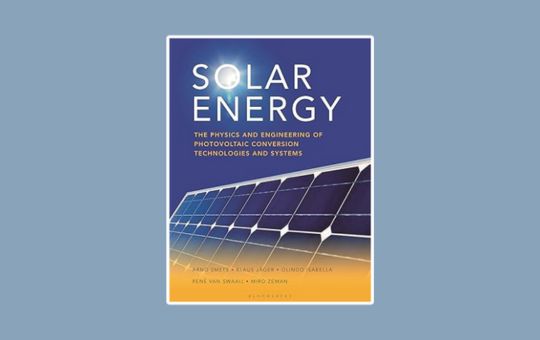
According to descriptions on sites like Barnes & Noble and Waterstones, it’s a 488-page tome (a bit wider in dimensions too, 7.3″ x 9.5″), published in early 2016 by Delft University authors aiming to merge physics and system design in one volume. It reads less like bedtime material, more like the anchor text for anyone deep into solar tech.
Our research shows (mainly via Goodreads reviews) that readers appreciate the balance; this is no vapid DIY pamphlet. One reader sums it up as “detailed but easy to follow,” noting it covers everything from sun-tracking to solar cell layers and storage, though—oh yes—it’s “way too much information for my brain,”. Another, using it alongside Smets’s MOOC, says it mirrors lecture content but in its own voice, extra problems, and slightly different phrasing that kind of complements. A third review flags it as an “in-depth knowledge base… helped me evaluate PV system models,” clearly for people ready to roll up their sleeves.
What it is & specs (the sprawl): A 488-page paperback (first edition, 2016, ISBN 978-1906860325) packed with physics fundamentals, PV technologies (crystalline, thin-film, third-gen), system components, design, economics, even solar thermal and solar fuels. Appendices deep into Maxwell’s equations, IV curves, DC-DC converters, basically, they didn’t hold back.
Standout feature? Hands down, the integration of physics fundamentals with real-world system design, including exercises and charts. Reviewers learning via MOOC mention that exercises helped cement complex ideas, sparky and tangible.
Drawback? This isn’t a relaxed cruise in the sun. It’s intense. “Way too much information for my brain” isn’t sarcastic. Based on reviews, this book borders on overwhelming for anyone not already versed in undergrad physics or engineering.
✅ Pros
- Authoritative depth, bridges PV physics and system engineering
- Exercises and visual aids that reinforce complex theory
- Great companion to the MOOC; solid reference for serious learners
⚠️ Cons
- Dense, some readers felt cognitive overload
- Not for light perusal, this book expects brain engagement (and maybe coffee)
Ideal for: university students, researchers, industrial engineers, design pros, and anyone following Smets’s DelftX MOOC who wants textbook-level rigour. Not ideal for casual readers hunting quick solar tips.
Earthava’s take: This is a trusty companion if you’re ready for the deep end, not pop-science, but real substance. If you’re building solar literacy (or systems), it’s earned its shelf space.
Solar Energy Definition
Solar energy is the radiant light and heat from the sun that reaches Earth. Solar energy can be harnessed through a range of ever-evolving technologies like solar heating, photovoltaics, solar thermal electricity, and solar architecture, which can provide benefits to the environment, as well as the economy.
Solar energy can be harnessed to provide electricity in a variety of ways. It also includes direct heating or cooling of water or air, usually done with the use of sunlight collected by a solar thermal collector or through a photovoltaic panel that transforms light into electrical energy. For solar energy to become more widely adopted, it must be cost-competitive with traditional methods of generating electricity. The efficiency of solar panels has increased dramatically over time – modern thin-film cells have an efficiency of up to 25%, while older conventional silicon cells have an efficiency of up to 17%.
Solar energy is clean and renewable, but it is also intermittent: most locations get only 6 to 7 hours of full sun per day. Worldwide there are now many large and small solar thermal power plants as well as solar water heaters. The largest solar thermal power plant in the world is located in California’s Mojave Desert.
Why Is Solar Energy Important?
The sun is one of the most abundant sources of energy on Earth. It provides us with more than enough energy to power our homes and businesses.
Solar energy is a clean, renewable resource that has the potential to supply all the world’s energy needs.
Solar power is now being used by homeowners, businesses, and utilities in every state around the country. As technology improves and costs continue to fall, solar power will become an increasingly important part of our country’s energy mix.
Here are some reasons why solar energy is so important:
Helps fight climate change – Burning fossil fuels for electricity releases greenhouse gases into the atmosphere that contribute to climate change. Switching to renewable sources like solar helps reduce these emissions by avoiding burning fossil fuels for electricity generation and transportation.
Protects our air quality – Solar power plants use no raw materials or water in their operations, reducing their environmental impact compared with conventional fuel-fired plants. They also emit no air pollutants or greenhouse gases during operation.
Reduces our dependence on foreign oil – Every 1 million kilowatt hours of electricity produced from coal-fired generation produces 4,900 pounds of carbon dioxide (CO2).
How To Learn Everything About Solar Energy?
There are several ways to learn everything about solar energy.
The first way is to visit your local library or bookstore and look for books on solar power. You will find many excellent texts that provide a wealth of information on this subject. You can also check out some websites that provide information on solar energy, such as the U.S. Department of Energy’s website at www1.eere.energy.gov/solar/.
Another way to learn more about solar energy is by talking with people who have experience with it. Many people who have installed solar panels in their homes are willing to share their experiences with you, and they may even offer advice on how to get started yourself.
Conclusion
This list includes some of the most interesting, informative, and enjoyable solar energy books. It covers several different topics, ranging from choosing the right angle for your panels to the latest breakthroughs in solar technology. Once you have finished reading these books, don’t forget to share them with your friends.


